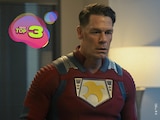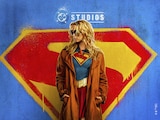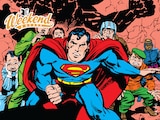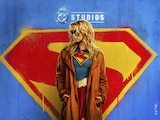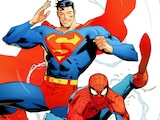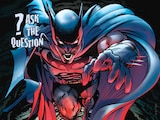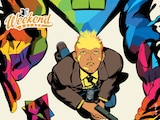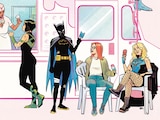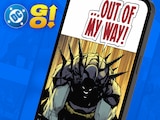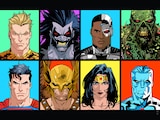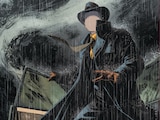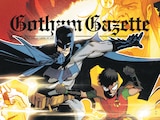Kelly Thompson and G. Willow Wilson and Tini Howard and Leah Williams and Delilah S. Dawson and Josie Campbell and Nicole Maines. All women with writing credits on major DC comic book titles this March alone. But in Women’s History Month, we have to acknowledge that it was once much more difficult to find a comic that women were hired to write. The curious thing is that if you go very far back, to the days before Superman, many of comics’ editors and writers were women. It was a patriarchal boys’ club culture which would drive women out as the medium found its legs, with only a few bold pioneers stemming the tide.
Over the first fifty years of DC history, fewer than forty women were credited as writers—many only years after the fact, and more as co-writers with a male counterpart. It’s entirely possible that there are many more women in comics who wrote our favorite stories but were hidden from history, like Joye Hummel and Dorothy Woolfolk, whose impact we have yet to discover. But when we’re talking about the history of women as DC comic book writers, here are some names you should know.
(Special thanks to former DC president Paul Levitz, who provided additional notes for some names omitted from the first edition of this article.)

Emma C. McKean
The first woman to contribute original material to a comic book, creating activity pages for 1935’s New Comics #1-2. In 1936, she became the first female writer for National Publications with a two-issue feature in issues #3-4, “Sara Lou Sunshine.”
Connie Naar
An early assistant editor at National Publications, Naar contributed “Junior Funsters” illustrated stories to issues of New Fun, More Fun and New Fun Comics in the 1930s.
Merna Gamble
The first female writer with a significant serialized feature under National Comics, Gamble wrote and illustrated an adaptation of Charles Dickens’ A Tale of Two Cities from 1936-1938 in New Comics #4-11 and continuing as New Adventure Comics #12-25.
Rosemary Volk
Contributed some text stories to New Comics #2 and #8, including “The Book Shelf,” “The Test of a Man” and “The Happy Four Club.”

Evelyn Gaines
Niece to one of the founding fathers of comic books, All-American Publications and EC Comics founder Max Gaines, Evelyn would be the first female writer on characters still featured in the DC Universe today. Writing for All-American Comics, Sensation Comics and All-Star Comics #3-5 between 1940 and 1944, she contributed features for some of All-American’s flagship characters including Johnny Thunder and Little Boy Blue.
Alice Marble
A celebrity 18-time Grand Slam tennis champion signed to be assistant editor on Wonder Woman, Alice Marble was credited with the magazine’s “Wonder Women of History” feature in issues #1-19, profiling iconic women from Florence Nightingale to Elizabeth Blackwell. (And that’s just the beginning! For much more on Marble, be sure to read Rosie Knight’s article on her remarkable life.)
Ruth Lyons Kaufman
Brought on to cover gaps in the writer’s bullpen as talent was drafted overseas to World War II, Ruth Lyons Kaufman wrote only a handful of comic scripts over three months: “Riddle of the Rodeo” in Adventure Comics #84, “Somewhere in the Pacific” in More Fun Comics #90, and “The Grade A Crimes” in Batman #16. Respectively, each of these credits made her the first woman to write Shining Knight, Aquaman and Batman.
Joye Hummel
Student of Wonder Woman creator William Moulton Marston and his creative heir apparent, Joye Hummel took over her mentor’s writing duties as his health started failing. On the Wonder Woman title from issues #12-29 and featured intermittently in Sensation Comics between issues #43 and #71, Hummel was possibly the first woman to write the most famous woman in comics.

Dorothy Woolfolk
An early editor at DC Comics and its predecessors, Woolfolk is said to have ghostwritten an untold number of stories during a career spanning from the 1940s to the 1970s, including many early Wonder Woman stories—the reason we have to give Hummel that “possibly” qualifier. Woolfolk’s greatest legacy may be her insistence as editor that Superman be given his own special weakness, leading to the creation of Kryptonite.
Natalie Krigstein
A prolific writer in the romance comics genre, Krigstein contributed features to Girls’ Love Stories, Girls’ Romances, Secret Hearts, Young Love and Young Romance between 1949 and 1952.
Leigh Brackett
“The Queen of the Space Opera,” Brackett is best known as the premiere sci-fi romance writer of her time, as well as her second career as acclaimed screenwriter for films such as The Big Sleep, The Long Goodbye and the first draft of The Empire Strikes Back. In 1953, Brackett joined her husband, similarly accomplished sci-fi writer Edmond Hamilton, in co-writing a story for Detective Comics #198, “The Lord of Bat-Manor.”
Zena Brody
Brody is best remembered as an editor on DC’s romance titles between 1956 to 1957. Record keeping on the credits in books like Girls’ Romances, Heart Throbs and Secret Hearts is spotty at best, but it’s generally understood that many romance editors frequently contributed their own stories to these anthology titles.

Phyllis Reed
Like Zena Brody before her, Phyllis Reed is on the books primarily as a romance editor. But as was the nature of DC’s romance titles at the time, it’s very likely Reed wrote her share of stories for her titles during her tenure from 1958-1963.
Liz Berube
Breaking into the mainstream through her newspaper strip Karen, Elizabeth Safian Berube was brought onto DC in 1969 as a new romance title editor. As was de rigueur, Berube most likely contributed some of her own writing to the titles she oversaw.
Debbie Anderson
Anderson was another romance editor following Brody, Reed and Berube, off the public records but most likely contributing to 1972 issues of Heart Throbs, Love Stories and more.
Barbara Friedlander
The first woman to create a lasting character for DC Comics, writer and editor Barbara Friedlander contributed to many of DC’s romance titles, but her greatest legacy was launching the teen comedy title Swing With Scooter with artist Joe Orlando in 1966. The title, featuring the titular Scooter as a teen pop music sensation stepping down to attend a normal high school, ran for 36 issues through 1972.

Maxene Fabe
The first of DC’s great female horror writers, with contributions to House of Mystery, House of Secrets, Plop! and even one memorable Superman and Lois story in 1972’s Superman’s Girl Friend, Lois Lane #129, “Serpent in Paradise.”
Mary Skrenes
Another Bronze Age horror contributor to DC, though best known today for her work at Marvel Comics and collaborations with Steve Gerber. Often contributing under the pen name of “Virgil North,” Skrenes wrote one Elongated Man story, “The Mystery Man Who Walked on Air,” in 1975’s Detective Comics #449, and would return to DC with Gerber on Hard Time in 2004.
Mary DeZuniga
Wife of Jonah Hex and Black Orchid artist and co-creator Tony DeZuniga, Mary contributed one story to 1972’s Sinister House of Secret Love #4.
Irene Vartanoff
If there’s such a thing as a celebrity fan, it was “Poison I.V.” Famous for her frequently published and often insightfully critical submissions to letter columns in practically all of DC’s titles through the 1960s, Vartanoff would contribute to the DC Universe herself by co-writing “Who Killed Lucy Lane?” with Cary Bates in Superman’s Girl Friend, Lois Lane #120—making her the first woman credited as a writer on a Superman comic.

Vin Amendola
Wife of artist and editor Sal Amendola, Vin is credited with co-writing one of Batman’s most legendary Bronze Age stories, Detective Comics #439’s “Night of the Stalker.”
Lee Marrs
One of the founders of the underground Wimmen’s Comix, Marrs contributed stories to Weird Mystery Tales and Plop! in the 1970s. Marrs would get further involved with the DC Universe in the 1990s, authoring a Zatanna miniseries, a two-part story in Batman: Legends of the Dark Knight, the one-shot Viking Glory: The Viking Prince and the Vertigo series Faultlines.
Laurie Rozakis
“Answer Man” Bob Rozakis sometimes enlisted his own wife as co-writer, crediting her on a Black Canary backup in Detective Comics #464 and a Clark Kent story in Superman Family #214.

Elizabeth Smith
Smith wrote backup features to Action Comics #475, #477 and #486, including a Lori Lemaris and a Lex Luthor story.
Val Eads
As an editorial assistant, Val Eads was best known for her personal correspondence with fans who wrote into the company. But Eads also wrote features herself, including at least one war story featured as a backup in Sgt. Rock #311.
Catherine B. Andrews
Another of DC’s female horror writers, with stories in Doorway to Nightmare and Secrets of Haunted House.

Joyce Katz
Another writer on Doorway to Nightmare, and elsewhere remembered as one of the founders of video game journalism.
Carla Conway
Once the partner of prolific comic author Gerry Conway, Carla occasionally assisted Gerry on scripts, including Superman #407 and Firestorm #19.
Laurie S. Sutton
Though best remembered by Legion fans as the editor who oversaw the epic “Great Darkness Saga,” Sutton was a capable author in her own right who wrote an Adam Strange backup feature running through Green Lantern #133-147.
Tamsyn O’Flynn
Perhaps the first female writer with a solid claim on writing Lois Lane as a protagonist beyond her signifier as “Superman’s Girl Friend,” O’Flynn wrote Lane solo stories through the early ‘80s in Superman Family #215-222 and Daring New Adventures of Supergirl #2-8.

Sharon Wright
Partner to Mike Grell, Wright co-wrote Grell’s Warlord for over a year between issues #52 and #71. As a solo writer, Wright would be one of the authors to take on the Action Comics Weekly challenge, writing a Black Canary feature from issues #609-634.
Sarah Gregory
Contributed “Santa Claus is a Killer” to The Unexpected #220.
Barbara Randall Kesel
Writer and editor of about a hundred different DC comics, usually with partner Karl Kesel. Barbara may be best known for her 28-issue run on Hawk and Dove, introducing Dawn Granger.

Dann Thomas
Partner of Roy Thomas, Dann Thomas was the co-writer and co-architect of DC’s “All-Star” titles of the 1980s, including All-Star Squadron, Infinity Inc and Young All-Stars, also co-writing most of Roy Thomas’ 50-issue run on Arak, Son of Thunder—not to mention Shazam: The New Beginning, Jonni Thunder, Last Days of the Justice Society, Crimson Avenger…once you start listing her credits, it’s hard to stop. Co-creator of Artemis Crock. And Icicle Jr. And Rick Tyler. And Lyta Hall. And Mister Bones. And Beth Chapel, and Yolanda Montez, and Mike Dugan, and…
Leslie Newman
Leslie Newman never wrote a single comic book, but we’re putting her on this list anyway. Why? Because she co-wrote the scripts for Superman: The Movie, Superman II and Superman III, that’s why.

Jan Duursema
Best known for her work in Star Wars comics, Duursema penciled over a hundred DC titles with her husband Tom Mandrake, but also did some writing herself for DC’s Advanced Dungeons & Dragons and an issue of Arion, Lord of Atlantis.
Randy Lofficier
Perennial collaborator with husband Jean-Marc Lofficier, frequently credited together as “RJM.” Prolific writers of French science fiction, the Lofficiers also brought us a brief run on Arak, Son of Thunder, and later some more DC titles, including the Elseworlds trilogy of Superman: Metropolis, Batman: Nosferatu and Wonder Woman: The Blue Amazon.
Carol Lay
A cartoonist often featured in MAD Magazine, Lay stepped over to Earth-C in 1985 to co-write Captain Carrot and His Amazing Zoo Crew: The Oz-Wonderland War.

Mindy Newell
Before early ghostwriting work by women like Joye Hummel and Dorothy Woolfolk was rediscovered, Mindy Newell was for a time considered the first female ongoing writer on Wonder Woman—covering the title both Pre-Crisis, in issues #326-328, and Post-Crisis, in issues #37-45. One claim Newell still maintains, however, is the first woman to write Catwoman, launching Selina’s first solo miniseries, along with a Catwoman feature in Action Comics #611-614. Newell also brought us a two-issue Lois Lane comic in 1986, thirteen combined issues featuring different iterations of the Legion of Super-Heroes and a fistful of Amethysts.
Women’s comics history, as we can see here, is often littered with choresome fill-in tasks, unlauded ghostwriting and dependency on a more patriarchy-friendly significant other. It’s a story you won’t just find in comics, but in every American artform and field of business through the 20th century into today. It’s part of a movement towards greater representation for women’s voices, who are still striving for equality. Each of these women laid a brick in the foundation. The tower that, someday, may shatter the ceiling, is yet unfinished. But those bricks are still coming in.
Alex Jaffe is the author of our monthly "Ask the Question" column and writes about TV, movies, comics and superhero history for DC.com. Follow him on Bluesky at @AlexJaffe and find him in the DC Community as HubCityQuestion.
NOTE: The views and opinions expressed in this feature are solely those of Alex Jaffe and do not necessarily reflect those of DC or Warner Bros. Discovery, nor should they be read as confirmation or denial of future DC plans.

